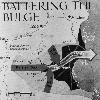

United StatesflagUnited Kingdom flagCanada1921flagFree French combatant2=flagiconGermanyNazi Germany (Nazi Germany) commander1=flagiconUnited States1912 Dwight D. Eisenhower (Dwight David Eisenhower) flagiconUnited States1912 Omar N. Bradley (12th U.S. Army Group (Twelfth United States Army Group)) flagiconUnited States1912 Courtney Hodges (1st U.S. Army (First United States Army)) flagiconUnited States1912 George S. Patton (3rd U.S Army (Third United States Army)) flagiconUnited Kingdom Bernard Montgomery (Bernard Montgomery, 1st Viscount Montgomery of Alamein) commander2=flagiconGermanyNazi Adolf Hitler flagiconGermanyNazi Walter Model flagiconGermanyNazi Gerd von Rundstedt flagiconGermanyNazi Hasso von Manteuffel flagiconGermanyNazi Sepp Dietrich flagiconGermanyNazi Erich Brandenberger flagiconGermanyNazi Ludwig SpindlerKIA strength1=840,000+ men, 1,300 medium tanks, plus tank destroyers, 394 artillery guns strength2=200,000 - 500,000 men HarvnbDelaforce2004p=376 1,800 tanks1,900 artillery guns and Nebelwerfers casualties1=flagiconUnited States1912 American:89,500(19,000 killed,47,500 wounded,23,000 captured or missing)~800 tanksHarvnbShaw2000p=168 flagiconUnited Kingdom British:1,408(200 killed, 1,200 wounded or missing) casualties2=67,200 - 100,000~600 tanks and assault guns casualties3=approximately 3,000 civilians killed
Campaignbox Battle of the Bulge Campaignbox Western Europe (1944-1945) Campaignbox Western Front (World War II) as the German offensive progressed east to west creating the nose-like bulge shape (salient) during 16-26 December 1944.
The Battle of the Bulge (also known as the Ardennes Offensive and the Von Runstedt Offensive) (16 December 1944 - 25 January 1945) was a major German offensive (German (German language): die Ardennenoffensive), launched towards the end of World War II through the densely forested Ardennes Mountains region (Ardennes) of Belgium (and more specifically of Wallonia: hence its French (French language) name, Bataille des Ardennes), France and Luxembourg on the Western Front (Western Front (World War II)). The Wehrmachts code name for the offensive was Unternehmen Wacht am Rhein (in English: "Operation Watch on the Rhine"), after the German patriotic hymn Die Wacht am Rhein. This German offensive was officially named the Ardennes-Alsace campaign by the U.S. Army (United States Army), but it is known to the English-speaking general public simply as the Battle of the Bulge, the "bulge (Salients, re-entrants and pockets)" being the initial incursion the Germans put into the Allies line of advance, as seen in maps presented in contemporary newspapers.
The German offensive was supported by several subordinate operations known as Unternehmen Bodenplatte (Operation Bodenplatte), Unternehmen Greif (Operation Greif), and Unternehmen W�hrung (Operation Wahrung). Germanys planned goal for these operations was to split the British and American Allied (Allies of World War II) line in half, capturing Antwerp, Belgium, and then proceed to encircle and destroy (encirclement) four Allied armies, forcing the Western Allies to negotiate a peace treaty in the Axis Powers (Axis powers of World War II) favor.
The offensive was planned with the utmost secrecy, minimizing radio traffic and moving of troops and equipment under cover of darkness. Although ULTRA suggested a possible attack, and the Third U.S. Army (United States Third Army)s intelligence staff predicted a major German offensive, the offensive still caught the Allies by surprise. This was achieved by a combination of Allied overconfidence, preoccupation with their own offensive plans, poor aerial reconnaissance, and the relative lack of combat contact by the First U.S. Army (United States First Army) in what was considered a "quiet sector". Almost complete surprise against a weakly-defended section of the Allied line was achieved during heavy overcast weather, which grounded the Allies strong air forces.
The objectives for the offensive were not realized. In the wake of the defeat, many experienced German units were left severely depleted of men and equipment as survivors retreated to the defenses of the Siegfried Line. For the Americans, with about 500,000 to 840,000 men committed and some 70,000 to 89,000 casualties, including 19,000 killed, the Battle of the Bulge was the single largest and bloodiest battle that American forces fought in World War II.
Conflict: Battle of the Bulge
Partof: World War II
Place: The Ardennes, Belgium, Luxembourg, and Germany
Result: Allied victory
Combatant1: flagiconUnited States1912




